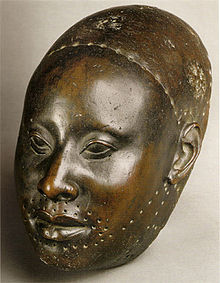| Revision as of 19:59, 16 June 2010 edit41.138.187.6 (talk)No edit summary← Previous edit | Revision as of 20:03, 16 June 2010 edit undo41.138.187.6 (talk)No edit summaryNext edit → | ||
| Line 5: | Line 5: | ||
| Over the years, many have come to merge foreign ideas of artistry and contemporary art with the traditional art forms found in West Africa. | Over the years, many have come to merge foreign ideas of artistry and contemporary art with the traditional art forms found in West Africa. | ||
| The traditional art forms among the Yoruba include but but are not limited to; beading, braiding, tattooing, |
The traditional art forms among the Yoruba include but but are not limited to; beading, braiding, tattooing, clay moulding and ceramic work, bronze casting, weaving and dyeing, sculpting etc. | ||
| There is also a vibrant form of customary ] known as ''Alarinjo'' that has its roots in the medieval period and that has given much to the contemporary ]. | There is also a vibrant form of customary ] known as ''Alarinjo'' that has its roots in the medieval period and that has given much to the contemporary ]. | ||
| ==References== | ==References== | ||
Revision as of 20:03, 16 June 2010


The Yoruba of South Western Africa (Benin Republic, Nigeria & Togo, also including parts of Ghana, Cameroon & Sierra Leone), have a very rich and vibrant artisan community, creating traditional and contemporary art. The custom of art and artisans among the Yoruba is deeply rooted in the Ifá literary corpus, indicating the orishas Ogun, Obatala, Oshun and Obalufon as central to creation mythology including artistry (ie the art of humanity)
Over the years, many have come to merge foreign ideas of artistry and contemporary art with the traditional art forms found in West Africa.
The traditional art forms among the Yoruba include but but are not limited to; beading, braiding, tattooing, clay moulding and ceramic work, bronze casting, weaving and dyeing, sculpting etc. There is also a vibrant form of customary theatre known as Alarinjo that has its roots in the medieval period and that has given much to the contemporary Nigerian film industry.
References
- "The Place of Susanne Wenger's Art in Yoruba Religion". Retrieved 2008-02-25.
| Yoruba religion (Orisa-Ifá) | |||||
|---|---|---|---|---|---|
| Spirits |
| ||||
| Countries of development | |||||
| Topics | |||||
| Sacred sites | |||||
| Legendary figures | |||||